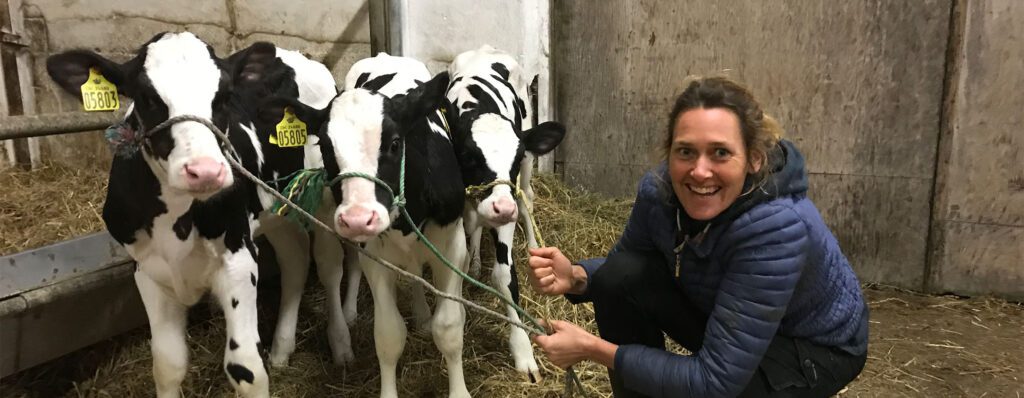

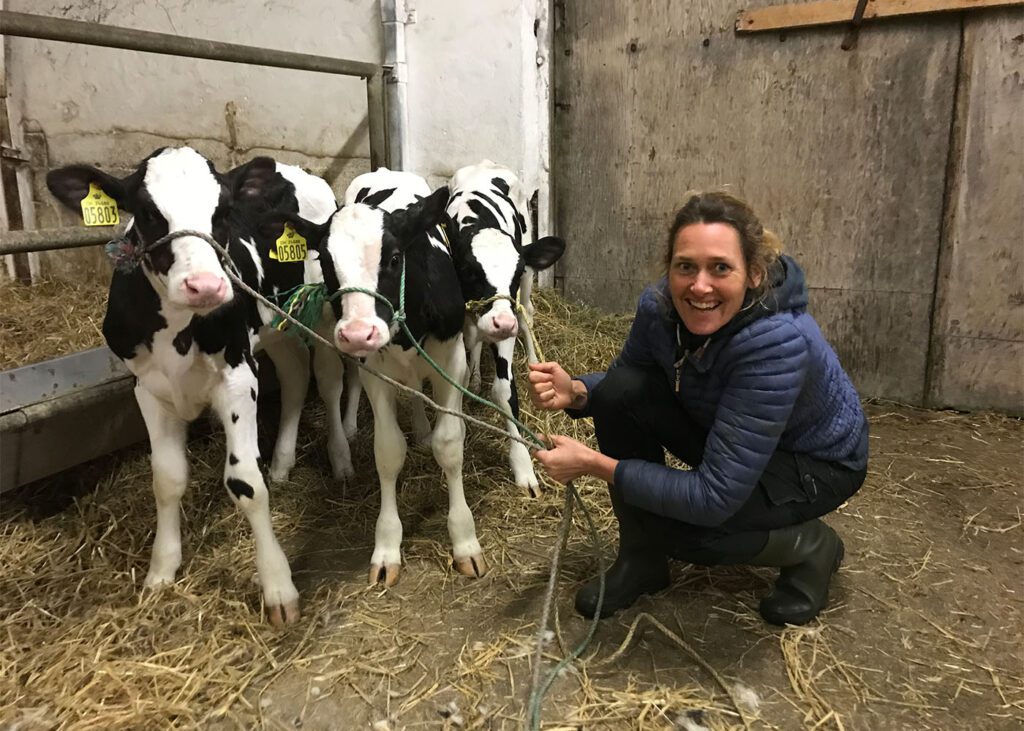





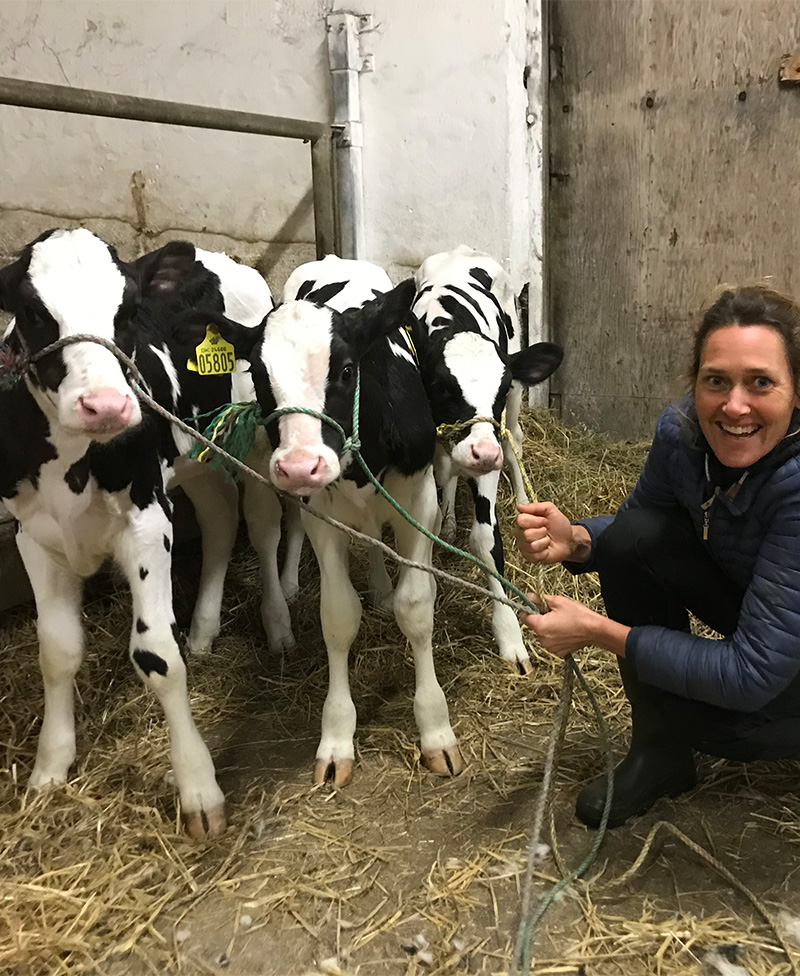

In cattle breeding, MOET and OPU/IVF are the main activities in efforts to develop the next generation of modern, functional and sustainable farm animals.
Superovulation is the term for the hormone treatment that is necessary for the donor to release more eggs than the one that is normally released from the ovaries in each cycle. The treatment starts in the middle of the cycle (between 8 and 14 days from the last heat). Then a new heat is induced with prostaglandin and the donor is inseminated. The flushing of the eggs is done one week after insemination.
Together with the herd owner, the hormone treatments and ET course are planned based on the donor's age, lactation, and heat cycle. Heifers can be started for ET as early as after 2 heats, but in practice, donor heifers has to be at least 11-12 months old and of a certain size before starting the hormone treatment. Lactating cows should wait until they are in safe positive energy balance after calving (90 to 120 days after calving). For both heifers and cows, it applies that the previous heats must be clear, regular, and result in the formation of a good functional corpus luteum in the ovary before starting.
A flush will often consist of a varied selection of both good and bad eggs and also often some unfertilized. An average flush will give between 5 and 7 usable embryos, but it covers very large variations. In some cases, there may be donors who give a lot of eggs (up to 30). At between 10 and 15% of all donors, only unfertilized eggs are found.
When the embryos are found and sorted under the microscope, a selection must be made. The best quality can be frozen for later use or export. The poorer quality ones must be transplanted fresh, which means that there must be surrogate mothers (recipients) ready on the flushing day. These surrogate mothers are already synchronized with the donor so that they are in the same cycle as the donor. In practice, the surrogate mothers are treated with prostaglandin the day before the donor is treated. Thus, both the donor and all recipients are in heat on the same day. With care and good records, between 60 and 70% pregnancies can be expected.
Embryo transplantation (ET) is a technique that was developed in the early 1970s as a method of increasing the number of offspring from elite cows in cattle breeding. The leading countries at this time were particularly Germany, Holland, and the USA, but on many fronts surpassed by Denmark via the Royal Veterinary and Agricultural University. Forskere som N.O.Rasbech, Torben Greve, Henrik Lehn-Jensen, Poul Hyttel og Henrik Callesen har i perioder stået som pionererne og er i dag internationalt anerkendt for deres forskningsindsats indenfor den bioteknologiske udvikling.
The first successful commercial embryo transplants were performed in Denmark in the late 1970s. Since then, the technique has been widely accepted and used in the cattle industry and has become an important method for increasing the number of offspring from the best breeding animals.
Superovulation is the term for the hormone treatment that is necessary for the donor to release more eggs than the one that is normally released from the ovaries in each cycle. The treatment starts in the middle of the cycle (between 8 and 14 days from the last heat). Then a new heat is induced with prostaglandin and the donor is inseminated. The flushing of the eggs is done one week after insemination.
Together with the herd owner, the hormone treatments and ET course are planned based on the donor's age, lactation, and heat cycle. Heifers can be started for ET as early as after 2 heats, but in practice, donor heifers has to be at least 11-12 months old and of a certain size before starting the hormone treatment. Lactating cows should wait until they are in safe positive energy balance after calving (90 to 120 days after calving). For both heifers and cows, it applies that the previous heats must be clear, regular, and result in the formation of a good functional corpus luteum in the ovary before starting.
A flush will often consist of a varied selection of both good and bad eggs and also often some unfertilized. An average flush will give between 5 and 7 usable embryos, but it covers very large variations. In some cases, there may be donors who give a lot of eggs (up to 30). At between 10 and 15% of all donors, only unfertilized eggs are found.
When the embryos are found and sorted under the microscope, a selection must be made. The best quality can be frozen for later use or export. The poorer quality ones must be transplanted fresh, which means that there must be surrogate mothers (recipients) ready on the flushing day. These surrogate mothers are already synchronized with the donor so that they are in the same cycle as the donor. In practice, the surrogate mothers are treated with prostaglandin the day before the donor is treated. Thus, both the donor and all recipients are in heat on the same day. With care and good records, between 60 and 70% pregnancies can be expected.
Embryo transplantation (ET) is a technique that was developed in the early 1970s as a method of increasing the number of offspring from elite cows in cattle breeding. The leading countries at this time were particularly Germany, Holland, and the USA, but on many fronts surpassed by Denmark via the Royal Veterinary and Agricultural University. Forskere som N.O.Rasbech, Torben Greve, Henrik Lehn-Jensen, Poul Hyttel og Henrik Callesen har i perioder stået som pionererne og er i dag internationalt anerkendt for deres forskningsindsats indenfor den bioteknologiske udvikling.
The first successful commercial embryo transplants were performed in Denmark in the late 1970s. Since then, the technique has been widely accepted and used in the cattle industry and has become an important method for increasing the number of offspring from the best breeding animals.
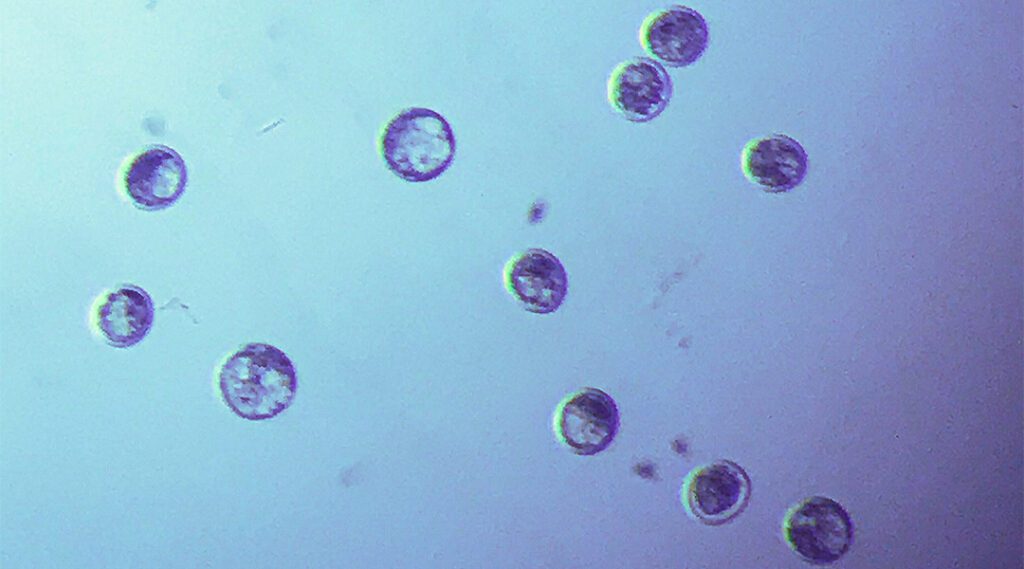





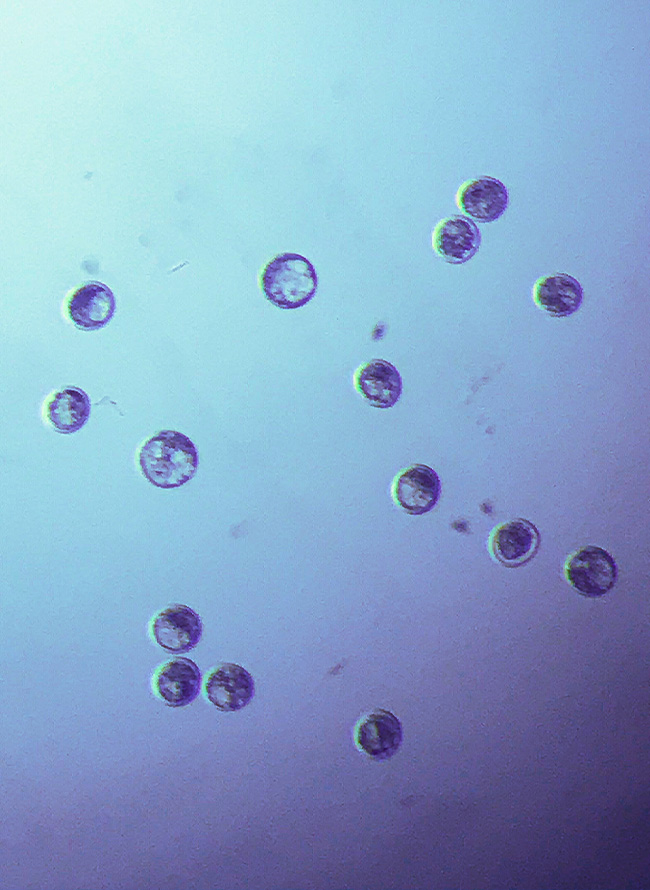

A well-proven technique that is now used routinely in modern cattle breeding. The technique is a multi-step process that starts with the aspiration of immature eggs (oocytes) directly from the ovaries. Using ultrasound scanning, the immature eggs can be extracted through a vaginal probe with a needle puncture of the ovary follicles. The immature eggs are found under a microscope and then matured in incubators under carefully controlled conditions. The next day, the eggs are fertilized in petri dishes in the laboratory. The eggs are then incubated for an additional 6-7 days, after which the fertilization results can be seen under a microscope. As a rule of thumb, one can expect to aspirate 10-15 eggs per session. Of these, about 6-8 will be of usable quality for maturation and cultivation. On average, 2 to 3 embryos are expected after cultivation.
This OPU procedure can be repeated every other week (MOET can be performed approximately every 5th week). The advantage of the technique is that it allows starting embryo production from the breeding animal a little earlier than with conventional ET. The technique can be performed without hormone treatment, but a short treatment with FSH preparations is often preferred before the OPU session.
Other advantages may include that the technique can be used if conventional ET does not work optimally. Additionally, eggs can be aspirated from slaughtered animal ovaries. Either after slaughter or after the death of injured breeding animals. This way valuable genetics can be saved. OPU/IVF requires optimal hygiene and special laboratory conditions. In addition, specialized personnel are required for both the aspirations and laboratory work.
The Ovum-Pick-Up and IVF techniques were developed as a human technique in the 1970s and the first baby was born in England in 1978. Since then, the techniques have also been used in livestock breeding. During the 1990s, the development picked up speed and the first commercial IVF calves were born around the world in this period. In the beginning, the results were not very good, but with the development of special cultivation media, the results improved. In 2021, 20% of all EU-produced embryos were produced via OPU/IVF.
A well-proven technique that is now used routinely in modern cattle breeding. The technique is a multi-step process that starts with the aspiration of immature eggs (oocytes) directly from the ovaries. Using ultrasound scanning, the immature eggs can be extracted through a vaginal probe with a needle puncture of the ovary follicles. The immature eggs are found under a microscope and then matured in incubators under carefully controlled conditions. The next day, the eggs are fertilized in petri dishes in the laboratory. The eggs are then incubated for an additional 6-7 days, after which the fertilization results can be seen under a microscope. As a rule of thumb, one can expect to aspirate 10-15 eggs per session. Of these, about 6-8 will be of usable quality for maturation and cultivation. On average, 2 to 3 embryos are expected after cultivation.
This OPU procedure can be repeated every other week (MOET can be performed approximately every 5th week). The advantage of the technique is that it allows starting embryo production from the breeding animal a little earlier than with conventional ET. The technique can be performed without hormone treatment, but a short treatment with FSH preparations is often preferred before the OPU session.
Other advantages may include that the technique can be used if conventional ET does not work optimally. Additionally, eggs can be aspirated from slaughtered animal ovaries. Either after slaughter or after the death of injured breeding animals. This way valuable genetics can be saved. OPU/IVF requires optimal hygiene and special laboratory conditions. In addition, specialized personnel are required for both the aspirations and laboratory work.
The Ovum-Pick-Up and IVF techniques were developed as a human technique in the 1970s and the first baby was born in England in 1978. Since then, the techniques have also been used in livestock breeding. During the 1990s, the development picked up speed and the first commercial IVF calves were born around the world in this period. In the beginning, the results were not very good, but with the development of special cultivation media, the results improved. In 2021, 20% of all EU-produced embryos were produced via OPU/IVF.
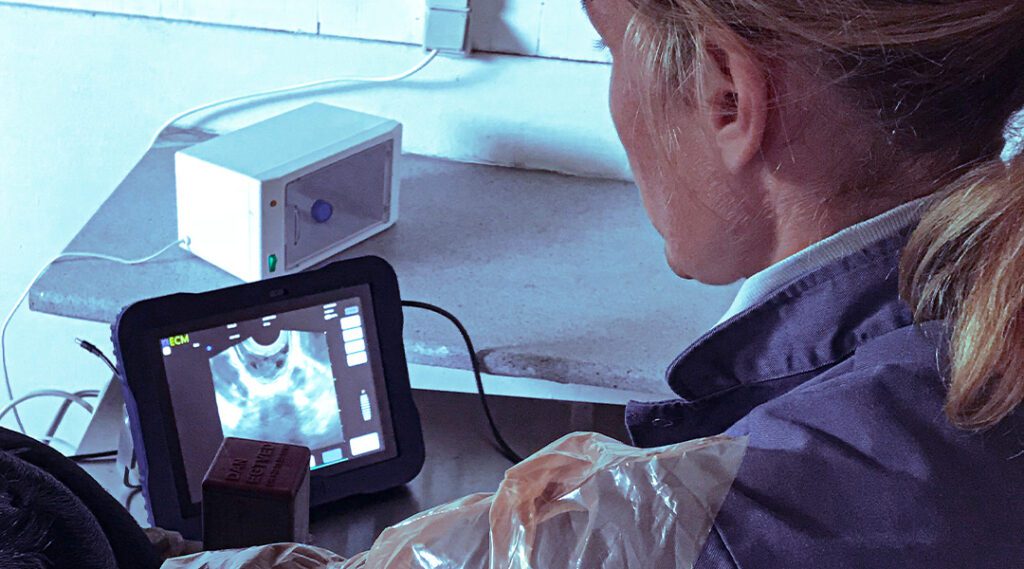







In the period 2013-2018, TransEmbryo collaborated with Aarhus University on the practical implementation of the OPU/IVP method in Denmark. The goal was to take the techniques out of the research and university environment and into a cattle breeding use. In close collaboration with Professor Henrik Callesen and IVF lab technician Anette Møjbæk Petersen, it was possible to create internationally comparable results.
The project also laid the foundation for the acceptance of commercial use of the technique in Denmark.
EliteOva is a research project that aims to develop a method for selecting calves with a variety of desirable genes. The project aims to ensure faster genetic progress in breeding dairy cows to make the production of Danish milk as environmentally friendly and efficient as possible.
The project is administered by the University of Copenhagen and TransEmbryo acts as a partner in the project.
You can always send us an email through the form or on our email directly. You are also very welcome to give us a call.
We are a biotech company with a focus on reproduction technologies. We are based in Tirsvad, Denmark.